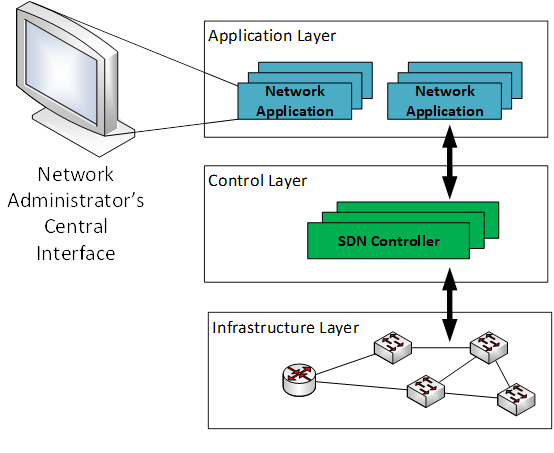
Software-defined networking (SDN) is changing the way networks are managed and designed. In this article, we take a look at how an SDN approach can be of great benefit to VoIP and video telephony deployments in particular.
Quick overview of SDN
SDN represents a major paradigm shift in the way networks are designed and administered. As we noted in a previous article, in an SDN deployment, individual network devices are not configured independently, but are simply added to the network and are managed from a central location.
Not only is the network managed centrally, but a network automation capability allows various parameters to be adjusted dynamically based on particular changes in network behavior. The powerful flexibility that SDN offers is ideal for the specific requirements of both voice and video systems.

Economies of scale
Before continuing, it should be made clear that SDN is not for everyone. SDN is of no benefit to most small-to-medium-sized businesses, and may not be cost effective for certain medium-to-large businesses. In order for SDN to be a valuable asset, the organization’s network must be large enough to warrant it, and it must be running applications that can benefit from it. For the former, an appropriate cost analysis should be conducted to determine SDN’s viability. VoIP and video telephony are applications that can benefit greatly from SDN. The following are the most lauded advantages that SDN technology provides for VoIP deployments.
Quality of service
By far the most cited benefit of SDN for VoIP is the smarter and more efficient deployment of quality of service mechanisms. When deploying any VoIP network, the configuration of QoS is absolutely essential. QoS should be implemented on all switches and routers through which voice and video traffic will be transmitted. Traditionally, these mechanisms are configured separately on each individual network device. This is fine if you have two routers and six switches on your network. But what if you have fifty routers and 1200 switches on nine large campuses and 85 branch offices? An arrangement such as this is not uncommon in today’s business world. Such a deployment has the following challenges:
- The man-hours needed to configure each and every device with QoS, let alone all other configuration parameters, is mind-boggling, as well as financially taxing
- Even with a configuration management system in place, the potential for a mistake to be made is not trivial
- The QoS configurations must be harmonized across all devices and all networks
- Even a single device that is not appropriately configured could wreak havoc on voice packets traversing that particular area of the network
- Troubleshooting network malfunctions or voice quality issues in such a deployment can be extremely challenging
Such are the challenges that SDN is designed to deal with. An SDN network is capable of:
- Harmonizing QoS policies across all network devices to ensure end-to-end QoS for all prioritized packets
- Interpreting higher-level QoS requirements and translating them into appropriate configurations that are automatically pushed out to network devices and applied immediately
- Allowing hundreds or even thousands of configuration steps to be applied simultaneously on the whole network, thereby minimizing downtime and man-hours spent and maximizing network efficiency
- Detecting the location of particular faults or failures, and either indicating them to administrators or proactively adjusting configurations to resolve the issues
In addition to these benefits, SDN is continually network-aware and responsive. This means that changes occurring on the network, either due to equipment failure, hacker attacks, or even legitimate fluctuations in traffic patterns, can cause the SDN intelligence to dynamically make adjustments to QoS, ensuring the smooth flow of voice and video traffic.
Additional benefits
As noted in a previous article, SDN is applied to a network in a series of network applications. Each application performs a particular function on the network. QoS mechanisms can be applied to various types of SDN applications, where each one deals with a particular aspect of QoS. Benefits of SDN for VoIP can also be deployed using other network applications, some of which include:
Signaling – VoIP uses the SIP protocol for signaling, and RTP to carry the actual voice packets. SDN applications can be designed that will detect the initial INVITE SIP message sent from the calling to the called device. The application can receive a copy of this SIP traffic and proactively push flows to establish a path for the RTP stream. A bandwidth requirement estimation can be made and a reservation of the required bandwidth can be initiated to ensure an acceptable quality of service.
Minimizing latency – Low latency is a must for VoIP and video applications, especially in networks spanning a country or a continent. By harmonizing network management, this latency can be kept at an absolute minimum.
Smarter bandwidth usage – Because of the intelligence that SDN applies to the entire network, the system has enough information to be able to intelligently and dynamically adjust routing and switching parameters throughout the network, thus delivering a more effective bandwidth usage, and enabling a more efficient use of bandwidth-demanding applications such as HD and 4K videoconferencing.
Conclusion
Voice and video require special network configurations to function correctly. In the past, this has been considered somewhat taxing, especially within extensively large and complex networks. With software-defined networking, meeting these requirements has been vastly streamlined, making network solutions for VoIP simpler, more easily deployable and widely available.
You may also like:
SDN: The cutting edge of network design
QoS for VoIP networks: IntServ vs. DiffServ
Quality of service must-haves for converged networks









Comments